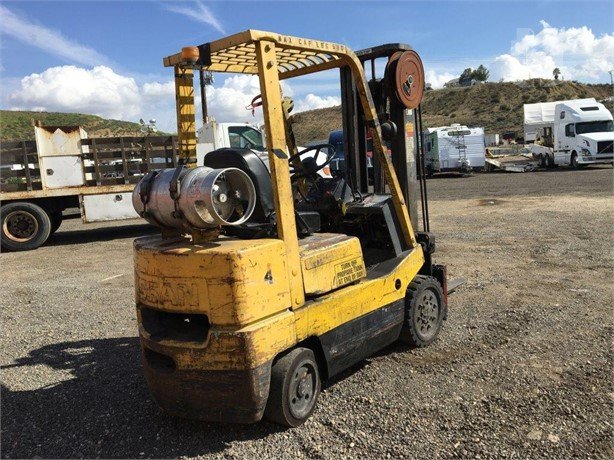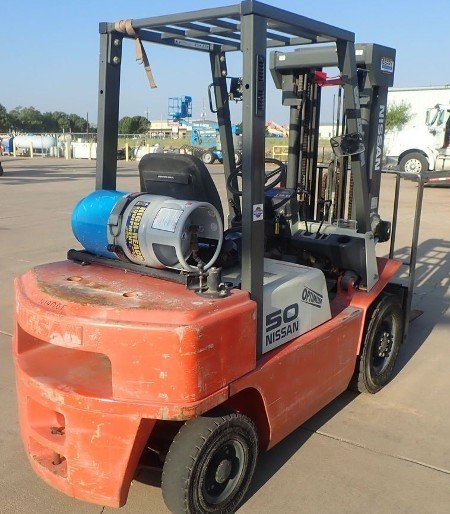A Story of Strength: The Legacy of Nissan Forklifts in Material Handling
Forging a Path Through Innovation
Imagine, just for a moment, a bustling warehouse in the early dawn of Japan’s industrial ascent—a place where raw materials become the lifeblood of a nation’s growth. It was here that Nissan forklifts began to play a pivotal role, not just in moving goods, but in driving an entire economic revival forward. As a pioneer with a rich heritage, Nissan helped carve the foundations of the material handling industry with its unwavering commitment to innovation. We’re about to unravel the enduring saga of Nissan’s legacy, a tale where strength is measured not just in horsepower, but in relentless progress.

The Early Years: Pioneering Material Handling Solutions
In the early years of Nissan’s forklift production, recovery and revitalization were the chants of a nation rebuilding from the rubble. Amidst this backdrop, Nissan emerged as the harbinger of a new epoch in the material handling industry. The unveiling of the first Japanese-made forklift in 1949 was nothing short of revolutionary; it was more than just a vehicle—it was a vessel of hope and resurgence. This first model, an electric-powered unit, dared to dream of a future where Japan would not only rise again but would lead with indomitable spirit.
During these formative years, Nissan focused intensely on creating forklifts that were robust, easy to maintain, and reliable. Models like the Nissan 1F Series roared to life, their engines symbolizing a heartbeat of progress. As the pages of the calendar turned, Nissan expanded its portfolio with the Nissan YGF Series, bringing gasoline-powered versatility into the bustling warehouses and noisy construction sites where the rebirth of civilization was taking place.
Nissan’s forklifts helped to construct a nation’s infrastructure, brick by brick, pallet by pallet. They were the silent soldiers in factories and harbors, helping multiple sectors flourish. From moving lumber to hoisting steel beams, these forklifts weren’t merely machines; they were embodiments of a potent vision.
But it wasn’t just about building forklifts; it was about crafting a promise of quality. Even in those nascent days, every Nissan forklift that left the assembly line carried with it a commitment to excellence and a reputation that would soon become synonymous with unparalleled quality in heavy machinery.
As we honor the legacy of these early forklift models, we recognize their place in the grand narrative of industrial history. They were essential to ushering in an era of Japanese prowess in manufacturing and set the stage for Nissan to grow into a global name—a name that carries with it a legacy of innovation, strength, and the unwavering drive to transform the material handling industry forever.
With such a formative start, Nissan began a legacy not just of building machines but of forging lifelines for industries across the globe, a legacy that continues to energize the material handling industry today.
Expanding Horizons: Global Reach and Diversification
As the rising sun of Japan’s economy illuminated new opportunities worldwide, Nissan detected a demand that transcended its native shores. The seeds sown by the robust Japanese-made forklifts soon germinated across the international landscape. The 1980s were a time of global expansion when Nissan’s CPF02 became a byword for dependability among warehouses in Europe and the Americas. Its no-nonsense design and reliability made it an instant classic.
The progress didn’t halt there. As the company moved into the 1990s, models like the Nissan PJ02 brought a new dimension to Nissan’s global offerings, coupling ease of use with the simplicity of maintenance, thus drawing a diverse demographic of customers. These models were not mere machines; they were enablers of efficiency for businesses big and small, standing up to the demands of diverse material handling needs, whether it was stacking pallets in a warehouse or serving the dynamic needs of distribution centers.
Into the early 2000s, the introduction of the Nissan 1F4 Series highlighted the brand’s commitment to pushing the envelope of technology and comfort. The 1F4 Series, with its advanced features and robust performance, became a staple in environments where strength and precision were paramount.
And then came the Nissan TX Series in the late 2000s. The TX Series redefined what operators could expect from a forklift’s ergonomics with its superior design catering to operator comfort. Alongside, Nissan’s proactive stance on sustainability became evident with any of the TX Series’ electric models, which underscored an environmental consciousness without compromising on power or performance.
Each of the Nissan models that followed played a part in strengthening the company’s international footprint. It wasn’t just the various terrains these machines conquered, but the hearts of operators and the respect of industry pundits that they won, establishing a lineage of forklifts that were as versatile as they were robust. Such was the impact that these Nissan models played an integral role in the worldwide material handling narrative, setting the stage for the brand’s continuous innovation and its evolution into what is now UniCarriers Americas.
The Nissan forklift legacy, alive and impactful, perpetuates through every product that now proudly bears the UniCarriers badge, yielding a history not just of vehicles but of a relentless pursuit of perfection that began with the CPF02 and continues to evolve with every new release.

1980’s Nissan CPF02

1990’s Nissan Pj02
Revolutionizing Material Handling: Innovation and Technological Advancements
Nissan’s legacy is not merely built on the robustness of its machines; it’s etched in the ceaseless tide of innovation that has coursed through its veins since inception. The company’s relentless pursuit of excellence birthed a myriad of technological advancements that have not just revolutionized material handling but have also redefined it.
In the sphere of electric forklifts, Nissan carved a niche with models known for their silent diligence and zero-emission footprint. But the innovation didn’t stop with just the power source. Nissan pioneered features such as the AC (Alternating Current) motor technology that not only provided smooth operation but also required less maintenance, significantly reducing the lifetime cost of the machines.
The 1980s saw Nissan take a leap with the development of the Nissan Optimum Series; which incorporated features such as auto-tilt leveling and side shifters, elevating precision and safety. The Optimum Series laid a foundation that would influence forklift design for years to come.
As the calendar flipped to the 1990s, Nissan continued to push boundaries with the Nomad Series, which combined the ruggedness required for outdoor terrain with the finesse needed for indoor performance. This model showcased Nissan’s innovative approach to tires and suspension that could withstand the test of any rugged surface thrown at it.
The dawn of the 21st century saw even greater strides with Nissan introducing the Comprehensive Interactive Nissan System (CINS), an onboard diagnostic system that decoded the forklift’s health in real-time, mitigating downtime and promoting preventative upkeep. Coupled with emissions control systems in their internal combustion engine models, Nissan signaled its dedication to more sustainable practices early on.
Nissan’s commitment to sustainability was also clear in their strides toward energy efficiency. The introduction of regenerative braking systems not only conserved energy but also lengthened the run-time of their forklifts, cementing Nissan’s forklifts as pioneers of efficiency.
The SP Series, considered a breakthrough in warehouse optimization, featured mast designs that allowed for high lift heights with superior stability, enabling storage solutions that reached for the sky. This innovation proved essential in maximizing limited space in warehousing operations worldwide.
Indeed, Nissan didn’t just revolutionize material handling; it orchestrated a movement towards a symbiotic relationship between man, machine, and the environment, embodied in every technological feat.
These innovations are a chronicle of Nissan’s enduring quest to abreast and surpass industry standards, sculpting a future where material handling solutions would be tantamount to a greener, more efficient, and safer world. The hallmark of a Nissan forklift was no longer just its ability to lift; it was its role as a testament to human ingenuity.
By embedding intelligence into the very fabric of its forklifts, Nissan forklifts are not just products of the past, but they continue to drive the narrative for a more innovative, more responsible industry future.

A forklift with the Comprehensive Interactive Nissan System installed
Enduring Legacy and Future Aspirations
The legacy of Nissan forklifts is not just a tale of past achievements but a resonant force that propels us into the future. As we take a step back to admire the vast panorama of Nissan’s innovations, we see more than a chronicle of machinery; we see a continuum of impact, a lasting change that has reshaped the very fabric of the material handling industry.
Nissan’s philosophy has been one of enduring commitment—to reliability, to ingenuity, and to the people who operate their machines. It is a commitment that has seen the company navigate past industrial waters and sail into the digital age with great fervor. The future of material handling, as shaped by Nissan’s aspirations, promises integrated solutions where automation, connectivity, and intelligent systems converge to create seamless workflows.
The quest for sustainable practices will undoubtedly continue to be a key driver of innovation. Anticipation mounts as the industry watches for Nissan’s next move in developing even more eco-friendly solutions, reducing the carbon footprint, and optimizing energy usage without compromising power or productivity. The dawn of electric and fuel cell technologies ushers in hope—hope for a cleaner planet and more sustainable operations.
Nissan’s inspirations for the future are also geared toward the augmentation of the operator experience through advancements in robotic assistance and learning algorithms that adapt to operator behavior. In the world Nissan envisions, safety is not just a priority—it’s an uncompromised certainty.
Moreover, the vision includes a global network of smart material handling systems that communicate across factories and borders, optimizing inventory control and logistics planning like the gears of a well-oiled machine. This is not a far-fetched dream but the next frontier Nissan is poised to chart.
As we stand at this juncture, we invite not just admiration but participation—in molding the future, in taking the wheel of the next generation of forklifts, and in being part of a movement that transcends the limits of today. This is the legacy Nissan bequeaths—a dynamic, evolving entity that is as much about forklift development as it is about global progress and the unsung heroes of the industry—the operators, the technicians, and the visionaries.
With open arms and a spirit of continual evolution, Nissan beckons a tomorrow that is built on the bedrock of its yesteryears yet strides boldly toward a new era. We encourage you to join us in this journey and be a part of shaping the material handling landscapes of tomorrow. Explore what lies ahead, get a glimpse of Nissan’s ever-progressive range, or engage us in dialogue on your needs at Racine Forklift Co.. Together, we drive not just forklifts, but global potential ever forward.